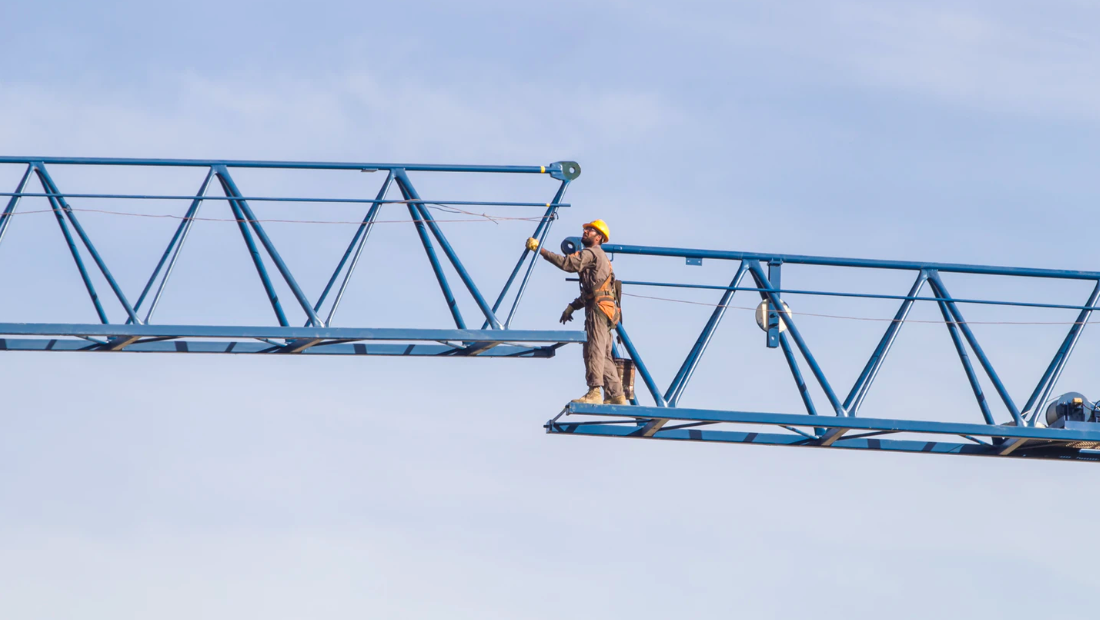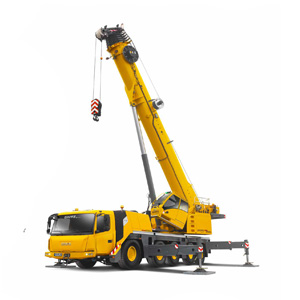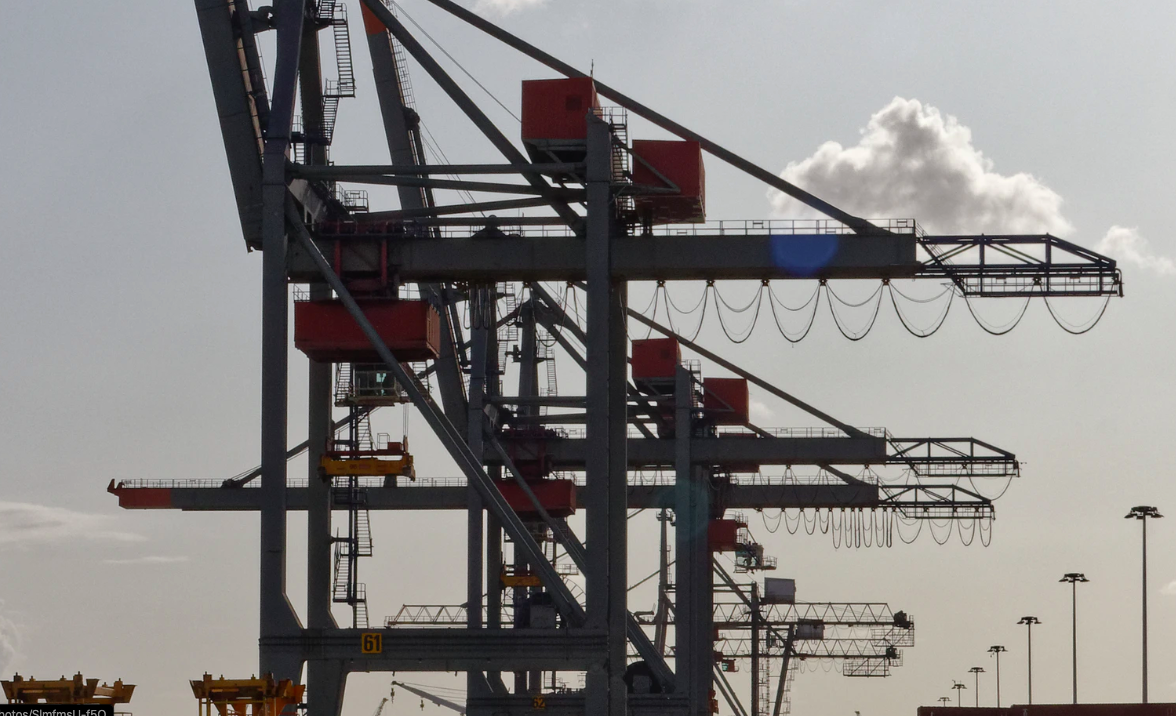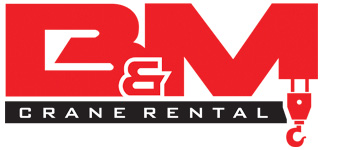A crane is an indispensable tool wherever heavy lifting is needed. For construction projects, it’s the only type of equipment that can move massive amounts of material or huge objects. On top of lifting things up well beyond human reach, they can also transport goods or materials around the worksite. However, have you stopped to ask yourself what kind of crane you need for your job?

When working in such extreme scenarios, a high level of precision and power is needed. To that end, there are almost as many different types of cranes as there are different worksites. Each type of crane has specific features and characteristics that make it particularly suited to a certain kind of job.
Picking the right crane will not only make your job easier but will also improve safety and save time. That’s why we created this guide to help you pick the right crane based on your needs.
Things to consider when choosing a crane:
Capacity
This is the most obvious aspect to consider when choosing a crane. Every crane has a maximum capacity that determines how much it can lift. It’s imperative that you establish the maximum weight you will need to move as part of your job. Not doing so can result in serious risks to your project, site workers, and a waste of time and money.
Boom and jib length
Equally as important is how high and wide the crane can reach. Remember that the crane will be static during operation, so your work site should be arranged so that everything is within reach. If a crane’s boom can’t extend as high as you need it, it won’t be much use.
Another consideration is that a crane can lift different amounts of weights at different levels of extension. In other words, a crane can lift more safely the less extended the boom is and less the higher or further out it goes. Conditions on the day, like a strong wind, can also affect how much you can lift safely.
Travel distance and terrain
First of all, the worksite itself should be in the right condition for a crane to operate properly and safely. The terrain should be flat and firm enough for a crane to be balanced and stable. The dimensions of the worksite will also determine if and how far the outriggers of the crane can extend.
However, the road and terrain to the worksite are also important considerations. You might need to consider a type of truck crane for longer-distance travel. If the road is sufficiently hard to traverse, you might need an all-terrain or crawler crane. The last thing you want to happen is for the crane to not even be able to access your site.
Other site obstructions
Trees, powerlines, or other buildings are just some of the things that can make operating a crane tricky. You will need to assess these conditions on your site as they may affect which type of crane will be the easiest and safest to use. Each type of crane usually has its own safe operating guidelines with regard to this.
Crane rental company and condition
If you are looking for a crane, you are looking for a piece of machinery to do some extremely hard, and potentially dangerous, work. If something goes wrong, it can be life-threatening to your site workers and very, very expensive.
Always make sure to do business with a reputable crane rental company and make sure the crane is in good condition. Cranes need to be inspected at least once a year (more for certain types) so ensure this is the case.
Most companies provide their own operator along with the crane, so make sure they are OSHA certified.
What types of cranes are there?
Due to how many different types of cranes there are for specific situations, many of these will overlap. For example, you will find crawler, all-terrain truck, and stationary boom cranes. However, we identified the most distinct and important classes to guide you in your decision.

Telescopic crane
These cranes use a large boom with a number of cross-sectional parts that fit inside each other. A hydraulic mechanism pushes each segment out to lengthen the boom when used. For this reason, it’s also often called a hydraulic crane.
The main advantages of telescopic cranes are their mobility and superior height. They can be fitted with a platform for persons to stand on and work from or a lifting hook mechanism like a normal crane.
When should you use a telescopic?
Telescopic cranes are often used to transport goods from one place to another. They are usually quite mobile and they are usually higher than most cranes making stacking easy. Multiple telescopic cranes are often used together in ports or harbors to transport ships. They are also often used in rescue operations.
A telescopic handler crane is a variant often used to install frame trusses or move stacks of building materials.
Truck crane
The name says it all. This is a type of crane where the boom is mounted directly on a truck-like vehicle that runs on wheels. They are also sometimes referred to as “boom trucks.” Truck cranes can vary a lot in appearance and size. They can either like a normal hauling truck, such as the Manitex TC50155S or National NBT45 or like a massive construction vehicle.
Because they roll on wheels, they can be driven long distances to work sites. They are relatively maneuverable although they are more sensitive to site conditions than crawler cranes. Larger models can come with outriggers for better stability. Most can rotate 180° but some can go a full 360°.
Where should you use a truck crane?
Truck cranes are the easiest and cheapest options where worksites are located far away and roads are available. They are very flexible and are great when the job requires both lifting and delivery. Loading or unloading of storage items, doing elevated repairs, or road construction are perfect situations for this type of crane.
Crawler crane
Unlike truck cranes that use wheels, crawler cranes run on caterpillar tracks, like a military tank. Because of this, they also usually look more like a tank-like vehicle and less like a truck. They usually utilize a telescopic or lattice boom.
The tracks give them greater stability without having to use outriggers and they can maneuver on almost any terrain. However, this also makes them much heavier. Crawlers aren’t suitable to drive long-distance to a location but can be transported relatively easily on a truck.
Where should you use a crawler crane?
A crawler crane can be used in almost any land-based construction site. They are a good choice where the surface is not ideal, like on unprepared sites and when maneuverability is of the essence.
Off-road crane
These cranes are mounted on a four-wheel vehicle with high ground clearance and a relatively small cabin body. For this reason, and to keep them lighter, they only have one engine powering both the vehicle and crane.
Because they are often used on uneven terrain, they are fitted with outriggers. A wider set of tires and wheelbase also makes them more stable than they might appear. All-wheel drive and power steering make them easier to handle on rough terrain. Despite their appearance, however, they can’t be driven on the open road.
Where to use an off-road crane?
No guesswork needed – these cranes are built to function no matter how challenging the terrain of the worksite is. They are often used in bridge construction because they are some of the only cranes that can handle that kind of terrain. They are also usually kept on large construction sites in case they are needed.
All-terrain cranes
The difference between these and off-road cranes is that all-terrain cranes are larger with more wheels. There are even 18-wheeler versions and you can distinguish them by the wide-looking cabin at the front. They can be mounted with different booms that are usually stored horizontally from back to front across the long undercarriage.
These vehicle-mounted cranes can be driven on public roads. An all-wheel-drive system means it’s capable of traversing rough terrain although it’s not as easy to handle as an off-road crane. They also usually have huge maximum capacities of over 1,000 tonnes.
Where should you use an all-terrain crane?

All-terrain cranes are suited for the heaviest of crane lifting jobs. They can also be driven to virtually any site, although their size may limit access to certain places. For these reasons, they are even used for jobs like wind turbine erection and lifting large pre-built concrete sections.
Level-luffing cranes
These cranes are usually used to move objects from one location to another over and over again at a fixed level. Although they are considered to be static cranes, they do sometimes have the ability to be self-propelled (very slowly!).
A level luffing crane is sometimes designed to keep the hook at the same level, even when moving the boom up and down. In this case, the boom just determines how far its reach extends.
Where to use a level luffing crane?
Level luffing cranes are most commonly used for loading and unloading within ports or harbors. However, they are also suitable for construction sites where a lot of material needs to be moved. They are also great for moving objects slowly and carefully.
Tower crane
These are the massive steel framework structures we are used to seeing spanning across the sky. They are fixed to either a concrete slab in the ground or to the side of buildings. Because of this, they are the type of crane that can lift the highest and heaviest. Their height can also be increased on the job to grow with the building.
They are usually assembled at the beginning of the project and only disassembled once they have done their job.
Where should you use tower cranes?
Tower cranes are only feasible for very long and gargantuan building projects. It takes a lot of time and money just to install and maintain these types of cranes. That’s why they are mostly used to construct tall buildings like skyscrapers.
Overhead cranes
There are a number of different types of overhead cranes, so we have combined them here. These are all static, although some can have surprising maneuverability over the worksite
Bridge crane
A bridge crane has two tracks set up parallel to each other a certain height above the ground. The bridge or girder is another beam that can move from side to side on these tracks. The hoist is attached to the girder and can in turn move side to side on it, allowing it to move over the entire area below.
Gantry crane

A gantry crane works almost exactly like a bridge crane. However, instead of two stationary tracks, the girder is fitted to two A-frames on each side. These A-frames are mounted on wheels so that the crane can be moved.
Jib crane
A jib crane consists of a column and a horizontal jib arm with the hoist attached to it. Unlike a bridge crane, while the hoist can move the arm is either stationary. The column is itself also usually fixed in place. Most jib cranes can rotate, some up to 360°.
Where should you use overhead cranes?
Overhead cranes are mostly used in an industrial or manufacturing setting. They can work at high levels of precision and are particularly useful in the automobile industry, especially gantry or bridge cranes. They can sometimes be used in construction but their limited reach and stationary nature don’t fit too well.
Make easy work of heavy lifting by picking the right crane for the job
We really can’t stress enough how important it is to choose the right crane for your project. In this guide, we focused on cranes for land-use in construction or manufacturing. However, there are even specialized cranes for use in the ocean or in other areas.
Picking the right crane can lead to a streamlined and safe worksite, while the wrong crane can do exactly the opposite. So, do yourself a favor the next time you need a crane and spend some time answering the question, “what kind of crane is right for the job?”

